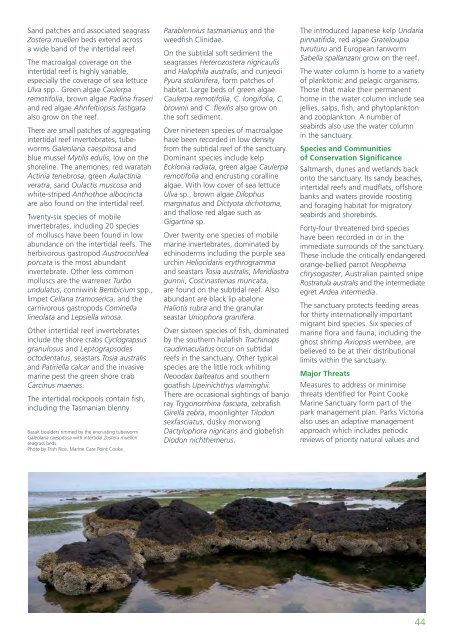Marine Natural Values Study Summary - Parks Victoria
Marine Natural Values Study Summary - Parks Victoria
Marine Natural Values Study Summary - Parks Victoria
Create successful ePaper yourself
Turn your PDF publications into a flip-book with our unique Google optimized e-Paper software.
Sand patches and associated seagrassZostera muelleri beds extend acrossa wide band of the intertidal reef.The macroalgal coverage on theintertidal reef is highly variable,especially the coverage of sea lettuceUlva spp.. Green algae Caulerparemotifolia, brown algae Padina fraseriand red algae Ahnfeltiopsis fastigataalso grow on the reef.There are small patches of aggregatingintertidal reef invertebrates, tubewormsGaleolaria caespitosa andblue mussel Mytilis edulis, low on theshoreline. The anemones, red waratahActinia tenebrosa, green Aulactiniaveratra, sand Oulactis muscosa andwhite-striped Anthothoe albocinctaare also found on the intertidal reef.Twenty-six species of mobileinvertebrates, including 20 speciesof molluscs have been found in lowabundance on the intertidal reefs. Theherbivorous gastropod Austrocochleaporcata is the most abundantinvertebrate. Other less commonmolluscs are the warrener Turboundulatus, conniwink Bembicium spp.,limpet Cellana tramoserica, and thecarnivorous gastropods Cominellalineolata and Lepsiella vinosa.Other intertidal reef invertebratesinclude the shore crabs Cyclograpsusgranulosus and Leptograpsodesoctodentatus, seastars Tosia australisand Patiriella calcar and the invasivemarine pest the green shore crabCarcinus maenas.The intertidal rockpools contain fish,including the Tasmanian blennyBasalt boulders rimmed by the encrusting tubewormGaleolaria caespitosa with intertidal Zostera muelleriseagrass beds.Photo by Trish Rice, <strong>Marine</strong> Care Point Cooke.Parablennius tasmanianus and theweedfish Clinidae.On the subtidal soft sediment theseagrasses Heterozostera nigricaulisand Halophila australis, and cunjevoiPyura stolonifera, form patches ofhabitat. Large beds of green algaeCaulerpa remotifolia, C. longifolia, C.brownii and C. flexilis also grow onthe soft sediment.Over nineteen species of macroalgaehave been recorded in low densityfrom the subtidal reef of the sanctuary.Dominant species include kelpEcklonia radiata, green algae Caulerparemotifolia and encrusting corallinealgae. With low cover of sea lettuceUlva sp., brown algae Dilophusmarginatus and Dictyota dichotoma,and thallose red algae such asGigartina sp.Over twenty one species of mobilemarine invertebrates, dominated byechinoderms including the purple seaurchin Heliocidaris erythrogrammaand seastars Tosia australis, Meridiastragunnii, Coscinasterias muricata,are found on the subtidal reef. Alsoabundant are black lip abaloneHaliotis rubra and the granularseastar Uniophora granifera.Over sixteen species of fish, dominatedby the southern hulafish Trachinopscaudimaculatus occur on subtidalreefs in the sanctuary. Other typicalspecies are the little rock whitingNeoodax balteatus and southerngoatfish Upeinichthys vlaminghii.There are occasional sightings of banjoray Trygonorrhina fasciata, zebrafishGirella zebra, moonlighter Tilodonsexfasciatus, dusky morwongDactylophora nigricans and globefishDiodon nichthemerus.The introduced Japanese kelp Undariapinnatifida, red algae Grateloupiaturuturu and European fanwormSabella spallanzani grow on the reef.The water column is home to a varietyof planktonic and pelagic organisms.Those that make their permanenthome in the water column include seajellies, salps, fish, and phytoplanktonand zooplankton. A number ofseabirds also use the water columnin the sanctuary.Species and Communitiesof Conservation SignificanceSaltmarsh, dunes and wetlands backonto the sanctuary. Its sandy beaches,intertidal reefs and mudflats, offshorebanks and waters provide roostingand foraging habitat for migratoryseabirds and shorebirds.Forty-four threatened bird specieshave been recorded in or in theimmediate surrounds of the sanctuary.These include the critically endangeredorange-bellied parrot Neophemachrysogaster, Australian painted snipeRostratula australis and the intermediateegret Ardea intermedia.The sanctuary protects feeding areasfor thirty internationally importantmigrant bird species. Six species ofmarine flora and fauna, including theghost shrimp Axiopsis werribee, arebelieved to be at their distributionallimits within the sanctuary.Major ThreatsMeasures to address or minimisethreats identified for Point Cooke<strong>Marine</strong> Sanctuary form part of thepark management plan. <strong>Parks</strong> <strong>Victoria</strong>also uses an adaptive managementapproach which includes periodicreviews of priority natural values and44
















